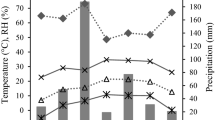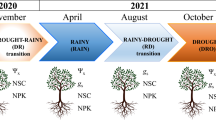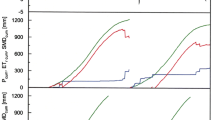Abstract
The phenology of sprouts (>1 year old, up to 1.5 m in height) and seedlings (<1 year old) of six woody species (four deciduous, one brevi-deciduous, and one evergreen) was examined during the dry season in a tropical deciduous forest of South India. Xylem water potential (Ψx), leaf relative water content (RWC; % turgid weight), and xylem specific conductivity (K S; kg s−1 m−1 MPa−1) of sprouts were measured on two occasions during the dry season. In addition, K S of seedlings (<1 year old) of one deciduous and one evergreen species was determined to allow comparison with sprouts. Ψx of deciduous species was significantly higher at the second sampling date and was accompanied by a significant increase in K S and RWC, while the brevi-deciduous and evergreen species did not show any difference in Ψx. Seedlings of Terminalia crenulata (deciduous) and Ixora parviflora (evergreen) had significantly lower K S compared to sprouts, while seedlings of all four deciduous species shed their leaves much earlier in the dry season than did conspecific sprouts. More favorable water relations of sprouts compared to seedlings during the peak of the dry season may explain the lower rates of die-back and mortality of sprouts observed in dry deciduous forests of India.

Similar content being viewed by others
References
Bond WJ, Midgley J (2001) Ecology of sprouting in woody plants: the persistence niche. Trends Ecol Evol 16:45–51
Borchert R (1994) Soil and stem water storage determine phenology and distribution of tropical dry forest trees. Ecology 75:1437–1449
Brodribb TJ, Holbrook NM, Gutierrez MV (2002) Hydraulic and photosynthetic co-ordination in seasonally dry tropical forest trees. Plant Cell Environ 25:1435–1444
Cavelier J, Aide TM, Santos C, Eusse AM, Dupuy JM (1998) The savannization of moist forests in the Sierra Nevada de Santa Marta, Colombia. J Biogeogr 25:901–912
Corlett RT, LaFrankie JV (1998) Potential impacts of climate change on tropical Asian forests through an influence on phenology. Climatic Change 39:439–453
Ewers FW (1985) Xylem structure and water conduction in conifer trees, dicot trees and lianas. IAWA Bull 6:309–317
Fanjul L, Barradas V (1987) Diurnal and seasonal variation in the water relations of some deciduous and evergreen trees of a deciduous dry forest of the western coast of Mexico. J Appl Ecol 24:289–303
Gartner BL, Bullock SH, Mooney HA, Brown VB, Whitbeck JL (1990) Water transport properties of vine and tree stems in a tropical deciduous forest. Am J Bot 77:742–749
Gillespie TW, Grijalva A, Farris CN (2000) Diversity, composition, and structure of tropical dry forests in Central America. Plant Ecol 147:37–47
Hart JJ, Radosevich SR (1987) Water relations of two Californian chaparral shrubs. Am J Bot 74:371–384
Mooney HA, Bullock SH, Medina E (1995) Introduction. In: Bullock SH, Mooney HA, Medina E (eds) Seasonally dry tropical forests. Cambridge University Press, Cambridge, pp 1–8
Murali KS, UmaShankar RU, Shaanker K, Ganeshaiah, Bawa KS (1996) Extraction of non-timber forest products in the forests of the Biligiri Rangan Hills, India. 2. Impact of NTFP extraction on regeneration, population structure, and species composition. Econ Bot 50:251–269
Saha S, Howe HF (2003) Species composition and fire in a dry deciduous forest. Ecology 84:3118–3123
Saha S, Hiremath A (2004) Anthropogenic fires in India—a tale of two forests. Arid Land Newslett 54
Scholander PF (1958) The rise of sap in lianas. In: Thimann KV (ed) The physiology of forest trees. Ronald Press, New York, pp 3–17
Shelden M, Sinclair R (2000) Water relations of feral olive trees (Olea europea) resprouting after severe pruning. Aust J Bot 48:639–644
Williams RJ, Myers BA, Muller WJ, Duff GA, Eamus D (1997) Leaf phenology of woody species in a north Australian tropical savanna. Ecology 78:2542–2558
Williams SE, Bolitho EE, Fox S (2003) Climate change in Australian tropical rainforests: an impending environmental catastrophe. Proc R Soc Lond Ser B 270:1887–1892
Turner NC (1981) Techniques and experimental approaches for the measurement of plant water status. Plant Soil 58:339–336
Author information
Authors and Affiliations
Corresponding author
Rights and permissions
About this article
Cite this article
Saha, S., BassiriRad, H. & Joseph, G. Phenology and water relations of tree sprouts and seedlings in a tropical deciduous forest of South India. Trees 19, 322–325 (2005). https://doi.org/10.1007/s00468-004-0395-y
Received:
Accepted:
Published:
Issue Date:
DOI: https://doi.org/10.1007/s00468-004-0395-y




